Are you thinking about learning Italian on your own but don’t know where to start? Check out the complete step-by-step process I followed to learn Italian from scratch on my own in just a few months!
The Italian language is truly enchanting. All it takes is that initial contact through a song, a movie, a trip, or interacting with a native speaker to be completely “enchanted” by the magic of this language.
In my case, my interest in the language was born unpretentiously through Italian songs featured in Brazilian soap operas.
Until one day, I decided: I want to and will learn Italian.
Unfortunately, it wasn’t an easy choice.
At the time, there were very few Italian courses in language schools or online, and I was still a student with limited financial resources, not wanting my parents to incur extra expenses.
That’s why I decided that I would do EVERYTHING on my own.
I gathered my courage, sat down, and created my own plan to learn Italian without a teacher or a course, allowing me to spend as little as possible while enjoying the learning process.
Today, I look back and see how that decision completely changed my life.
I learned Italian, and one thing led to another: I decided to do a university exchange in Rome, followed by an academic master’s degree in Milan, and now, who would have thought, I have been living and working here permanently since 2017!

What’s even more incredible is that when I decided to learn Italian in 2015, I could NEVER have imagined that in 2022, I would be living here in Italy and exploring so many incredible places, like the one in the photo (Perugia)!
So, if you’ve decided that you want to learn Italian from scratch and are willing to dive into the world of this amazing language, you’ve finally found the right post!
Here, I will show you the complete step-by-step process I used to learn Italian by myself in just a few months, without a teacher or a course, and help you create your own study plan.
Index
ToggleIs it worth learning Italian?
Why learn Italian? Is it worth? When we begin to approach the universe of this language, that’s the first question that comes to our minds.
Is it worth investing my time and energy in dedicating myself to learn Italian instead of another more widely spoken language?
Well, if you were to consider only the total number of speakers in the world, you might think it’s not worth it.
According to the Etnologue magazine, Italian ranks only as the 21st most spoken language in the world with 67 million speakers, while English, the most widely spoken, has 1.2 billion speakers.
But fortunately, the importance of a language is not directly proportional to the number of speakers in the world. Italian goes FAR beyond that: it opens doors to a universe of discoveries and beauties.

Italian is such an interesting and beloved language that it has become, according to The Washington Post, the 5th most studied language in the world, trailing only behind English, French, Spanish, and German.
This fascination is explained because, by learning Italian, people can connect with History, Science, Art, Music, Philosophy, Cinema, Cuisine, Religion, Fashion, Design – past and present aspects that have shaped and continue to shape Western society as we experience it today.
But in practice, you might ask, why should I learn Italian? Well, after many years of experience, I believe these are the top 5 reasons:
The 5 Key Practical Reasons Why Learning Italian Is Hugely Worth It
- Satisfaction and personal growth: a feeling of happiness and extreme personal satisfaction when learning such a captivating language and studying it for the love of it. Italian is delightful to listen to, fun to speak, and incredibly interesting to study, making the learning process more enjoyable compared to other languages.
- Cultural value: an opportunity to immerse yourself in one of the most interesting cultures in the world, with significant relevance in history, art, and culture from ancient times to the present day.
- Educational opportunities: a chance to pursue your undergraduate, master’s, or PhD studies at one of Europe’s top universities, such as the University of Bologna (the oldest in the world) or the Politecnico di Milano (Italy’s most prestigious).

- Professional opportunities: an advantage when applying to work for a major Italian multinational company. Italy is the eighth-largest economy in the world (2021 GDP) and home to numerous corporate giants, many of which have branches around the world.
- Family reconnection: the possibility of rekindling ties with your own heritage if you have any Italian ancestry.
Despite all these reasons, if learning Italian out of curiosity and passion is your sole motivation today, don’t worry: it’s a noble and more than valid reason!
For a long time, that was my only motivation as well. I don’t have Italian ancestry, and initially, I didn’t even dream of studying and working abroad.
I couldn’t have imagined what I could do with the language in my life, and I studied Italian out of love…
And in the end, here I am, living in Italy! So yes, learning Italian is worth it! And a lot 🙂
Is it possible to learn Italian on your own, without a teacher?
Yes, it is possible to learn Italian from scratch on your own, for two main reasons:
- Clear and Clean Phonetics:
In Italian, the pronunciation of a word almost always corresponds exactly to its written form. This means that, unlike in Spanish or English where a phoneme can change significantly depending on the word, in Italian, if you learn each phoneme well from the beginning, you are likely to be able to pronounce most words independently.
Therefore, with a lot of self-discipline and the right materials, you can indeed learn Italian on your own, just like I did, and you may even face fewer difficulties compared to other languages.
- Easier grammar than other Latin languages
Fortunately, Italian can be much easier to learn without a teacher than other Latin languages (I speak Portuguese and French and I can guarantee they are much more complex than Italian!).
It is true that latin languages follow many rules for verb conjugation, depending on the subject, but Italian gives you the advantage of having clearer and more intituitive structures that repeat constantly and are more regular than the other sister languages.
How to organize yourself to learn Italian on your own?
Before you start, it’s essential to understand that learning Italian on your own requires a focus on the 2 main pillars of self-study: (A) Active Study and (B) Language Exposure Activities.
A) Active Study of Italian:
Active Study of Italian refers to the process of assimilating didactic and explanatory content. It’s the moment when you actively engage with the study of the language, understanding and memorizing grammar rules, vocabulary, pronunciation, verb conjugation, and listening to dialogues.

In the world of self-study, you can’t escape the old and reliable technique of using a book and a notebook. For me, Active Study is essential for effective and rapid self-learning of Italian.
The premise for successful Active Study is to have excellent instructional material at your disposal that is easy to follow and designed for self-study.
In my experience with self-study, I would even say that learning Italian on your own without the support of a book is practically impossible.
This is because the book will set the pace for your learning and provide you with direction on what to study.
B) Language Exposure Activities in Italian:
At the same time, to learn Italian on your own, you absolutely need to engage in additional language exposure activities.
In other words, these are activities that allow you to experience Italian as a real language, giving it real communication functionality, such as consuming music, movies, news, and social media content in Italian.

However, for effective language exposure, don’t think that simply listening to music on Spotify and watching movies whenever you feel like it is enough.
It’s essential to be familiar with effective methods for exposing yourself to Italian in the right way, so that you can internalize all this exposure as a form of learning.
That’s why in this post, I’ve gathered the best tips and techniques for Active Study and Language Exposure that I personally developed and used to learn Italian by myself in 3 months.
Complete Step-by-Step: The 9 Essential Tips for Learning Italian on Your Own
The step-by-step process for learning Italian will be divided as follows:
- Steps 1-3 are methods I use for Active Study of Italian.
- Steps 4-7 are my techniques related to Exposure to the Italian Language.
- And finally, in steps 8 and 9, I will explain how to create a study plan that includes these activities and provide tips for developing self-discipline in your studies.
1. Begin by choosing a self-study book as your foundation and follow it from start to finish
To kickstart your learning journey, the first step is to acquire a good foundational Italian book, which will serve as the cornerstone of your active study.
This is because, to learn Italian without a teacher, you’ll need some sort of “coach” to guide you on what to study each day: the pace to follow, which rules to study, which vocabulary to absorb, the dialogues you need to listen to and practice…
And the book will be your personal coach. “MAMMA MIA” at Rocky Balboa-level!

Because trying to learn Italian without a foundational book, only by browsing random materials on the internet, would be like jumping into the ocean without knowing how to swim.
You would be overwhelmed with so much information and wouldn’t be able to structure the knowledge you’ve acquired.
That’s why this step-by-step guide starts with the essential choice of a good book.
1.1 1.1 Tips for Choosing a Book to Learn Italian on your own
There are 4 fundamental criteria for selecting a good book to kickstart your self-learning journey. They are:
- Choose a book written in your mothertongue – If you’re starting from scratch, having explanations written entirely in Italian would only make things more challenging. Books in your mother tongue can be helpful because they anticipate common difficulties and speed up the learning process in similar areas.
- Make sure the book can be used for self-study – The book should explicitly state that it’s compatible with self-study. Avoid books designed to be used with a teacher, as they often rely on the teacher’s guidance for instructions and answers.
- Opt for a book with a CD or multimedia content – It’s important that the book offers audio or video multimedia content, either including a free CD-ROM or providing free access to online audio resources. This is a crucial criterion to ensure that you not only focus on grammar but also have the opportunity to listen to dialogues, practice listening, and grasp pronunciation.
- Avoid “phrasebook” or “conversation” versions – These books are ideal for memorizing useful phrases but contribute little to true language study and learning.

1.2 Best Books to Learn Italian from Scratch on Your Own
In addition to following the criteria mentioned above, it’s important that your first book is also easy and enjoyable to follow.
A complex book with excessive depth can slow down your initial progress and even demotivate you from continuing to learn Italian.
That’s why my suggestion is to start with an essential and basic introduction to Italian book. Some people may have reservations about this type of book, but it’s how I ventured into the world of self-learning, and I can say that it worked perfectly well for me.
This kind of book gave me a basic understanding of concepts, vocabulary, and pronunciation: the initial push that encouraged me to delve deeper into my studies once I finished the first book.
To make it easier for you, I’ve prepared the top 3 easy and light books to learn Italian on your own:
1. Italian for dummies – 6 books in 1 – BEST OPTION
Authors: Francesca Romana Onofri, Karen Antje Möller e Teresa L. Picarazzi
Pages: 672
Editor: Alta Books
Description: “Italian All-in-One For Dummies appeals to those readers looking for a comprehensive, all-encompassing guide to mastering the Italian language. It contains content from all For Dummies Italian language instruction titles, including Italian For Dummies, Intermediate Italian For Dummies, Italian Verbs For Dummies, Italian Phrases For Dummies, Italian Grammar For Dummies, and Italian For Dummies Audio Set.”
2. Learn Italian with Paul Noble – FOR AUDIO LOVERS (that can’t stand reading)
Pages: Audio only – no books. 12 CDs, 13 hours of course + 40 pages of booklet
Editor: Collins
Description: “‘Italian with Paul Noble’ combines an exciting, new non-traditional approach to language learning with the easy, relaxed appeal of an audio-only product. No books. No rote memorization. No chance of failure. With Learn Italian with Paul Noble, Paul will introduce you to the basics of the Italian language and guide you through over 13 hours of everyday scenarios that will build your confidence. You will learn a huge range of vocabulary in no time at all, and be able to quickly make your new knowledge work for you in a variety of situations like asking for directions, eating out and talking about yourself. A native-speaking Italian expert will help you to perfect your pronunciation as you progress through the course. Language learning has finally become fun, enjoyable and accessible.”
3. Learn Italian – 5 books in 1 – FOR THOSE WHO LOVE LEARNING VOCANULARY AND REAL SENTENCES RATHER THAN GRAMMAR
Author: Paul Car
Pages: 769
Editor: Independent
Buy on Amazon
Description: If you want to learn Italian in an easy way and grow your vocabulary then keep reading… Most people don’t have a huge amount of extra time to spend learning a new language. Could you be one of them? Now, you can maximize your chances of learning Italian in less time compared to reading boring textbooks. Introducing: “Learn Italian: 5 Books In 1: This Book Includes 1000+ Italian Phrases, 1000+ Words In Context, 100+ Easy Conversations, Short Stories For Beginners Vol. 1-2”. 5 Manuscripts in 1 Book, This Book Includes: Over 1000 Easy And Common Italian Phrases, Over 1000 Easy And Common Italian Words In Context, Over 100 Easy And Common Italian Conversations, Italian Short Stories For Beginners Vol.1, Italian Short Stories For Beginners Vol.2.
Simply choose one of these books and adopt it as your foundational book for your initial journey, completing it from start to finish
If you’re unsure and can’t decide among them, you can start with “Italian for Dummies,” which was also my first book and I think it is super complete.
Your first mission will be to complete one of these books from start to finish, and once you’ve finished, you can move on to a more advanced book, and so on.
The important thing is to always have a book that guides you in self-study.
2. Prepare 2 notebooks: a larger one to follow the book and a smaller one for verbs and vocabulary.
After choosing your foundational book, you’ll need a dedicated space to jot down the most important points you’ve learned and to follow each of the lessons.
My advice is to use 2 different notebooks so you don’t get lost when reviewing the content: one main Italian notebook and a smaller one for vocabulary and exercises.
2.1 Use the main Italian notebook for rules and exercises from the book, as well as general notes. Use o Caderno de Italiano principal para regras e exercícios do livro e anotações em geral
In this notebook, you will follow the book’s lessons, jot down the rules from each chapter, create summaries, and complete exercises.

This will be your main Italian notebook for following the chosen foundational book. Here are some tips:
- Large notebook: Opt for a larger format notebook (A4 size) as it allows you to record more notes on fewer pages, making it easier to review topics.
- Organization: When starting any page, always write down the date, the topic studied, and the reference chapter from the book for easy review.
- Visual schematization: Whenever possible, use colors and highlighters, underline, and emphasize. It greatly aids in visually assimilating the studied content.
2.2 Use the small notebook to record vocabulary and practice verb conjugation.
This small notebook will be your support notebook, used for daily verb practice and recording new vocabulary.
Before you begin, divide the small notebook into two sections: the first section for Vocabulary (which will be used the most) and the other for Verb Conjugation.

I) Vocabulary Section::
Whenever you come across new words in your studies, you should jot them down here alongside their translation, creating an endless list.
- Technique for practicing Italian vocabulary: Cover the row of Italian words with one hand and read only the Portuguese side. Try to recall the corresponding Italian word, pronouncing it aloud. Note: When making the list, I recommend keeping the Italian words slightly separated from the translations so that you can cover them with your hand when practicing.
II) Verbs Section
For every new verb tense you learn, you will use this section to conjugate verbs by hand (just as we did in school when learning our mother language).
- Technique for practicing Italian verbs and conjugation: Each time you learn a new verb tense, conjugate several verbs in your notebook. For example, if you learned the Present tense in the book, take your Verb notebook and conjugate (without cheating) some verbs in all persons.
Example: “Cantare, Present – Io canto; Tu canti; Lui/Lei canta – Noi cantiamo – Voi cantate – Loro cantano.” Then, check for mistakes and correctness.
Practice conjugation in this way every day until you have a good grasp of the mechanism for each verb tense.
This was one of the secrets that greatly accelerated my language learning because it made my communication much more fluent and immediate.
3. Study Italian by always reading aloud, imitating the Italian intonation
One of the most challenging aspects of learning Italian on your own is having limited opportunities to speak. In other words, spending little time opening your mouth and pronouncing words and forming sentences out loud.
One technique that saved me from this and helped me become fluent more quickly was my method of “always studying out loud.” It works like this:
3.1 Learn and memorize the pronunciation of each Italian phoneme from the beginning
To be able to study aloud, it’s essential that you first dedicate a significant amount of time to the initial lessons in the book, which will teach you how to pronounce each phoneme correctly.
If you feel that’s not sufficient and you need more details, look for videos on YouTube to get a better understanding.
This is because, when you are self-taught, it’s extremely important to learn in the beginning how to pronounce each letter in Italian correctly.
Without mastering the correct sounds, you may cement incorrect pronunciation in your mind, making it very difficult to correct later on.
3.2 Study out loud and use the role-playing technique consistently
Once you’ve learned the phonemes well, you can start putting into practice the method that involves ALWAYS, absolutely ALWAYS, whenever you’re studying on your own, pronounce OUT LOUD EVERYTHING you read and write, literally opening your mouth and speaking.
My technique involved pronouncing the phoneme as accurately as possible based on what I had learned about phonemes and, at the same time, imitating the sing-songy rhythm of Italians (mamma mia!).
It may sound silly, but I even applied the role-playing technique. While studying, I would get into character as if I were an Italian named “Giulia.”

Literally: open your mouth, pronounce everything out loud, and immerse yourself in the Italian character.
Everything I read or wrote, I also pronounced out loud, imitating an Italian (based on what I was picking up from audios, movies, and videos with natives) and feeling like a Giulia!
Of course, in the beginning, you will make MANY mistakes, but by listening to audios from the book, songs, and movies, your pronunciation of phonemes, intonation, and rhythm will become more and more natural.
- Pronunciation exercise: The exercise that will help you with Italian pronunciation involves listening to the dialogue from the book at least 3 times and then recording your own pronunciation on your phone, repeating the same dialogue and getting into character. Then, simply compare your pronunciation recording with the original audio, looking for mistakes and correct pronunciations. If you have doubts, check the same word on Google Translate to confirm the correct pronunciation.
This is a crucial tip to unlock your Italian because it gets your mouth and tongue used to this new experience.
When you need to speak with someone, it will be a fluid and natural thing.
4. Learn to listen to Italian songs actively
We all know the importance of listening to music when we’re learning a language, and the same applies to Italian.
But simply listening to a song won’t get you far if you’re just enjoying the rhythm or mimicking the sounds, like a parrot learning to sing.

The golden tip that will turn the key to your Italian learning is learning to listen to music actively.
4.1 Use the Musixmatch app to learn Italian on your own
Listening to music actively means engaging cognitively with the song, attributing real words to the lyrics, and understanding their meaning.
To do this, you need to listen to music while reading the original lyrics and their translation.
It might seem complicated to organize, right?
But fortunately, there is an app that does all of this automatically: it’s “Musixmatch,” a free app available on the App Store or Google Play, which will become your best friend in the mission of learning Italian on your own.

When you download it, simply connect it to the Spotify on your phone, and you’re ready to go. Every time you start a song with Spotify, just open the Musixmatch app, and it will automatically display the original lyrics with the Portuguese translation and, even better, sync verse by verse with the music in real-time.

With Musixmatch, you can follow the Italian lyrics along with the corresponding translation already synchronized with the music.
When I started studying, this app was the biggest factor in speeding up my listening comprehension. I consider it essential on the journey to learning Italian on your own.
So, remember to listen to music actively using Musixmatch every day. Don’t skip this activity, and soon you’ll notice how much easier it becomes to understand the songs.
4.2 Best Songs to Learn Italian on Your Own
But what should you listen to? Fortunately, that won’t be a big problem.
The Italian music scene is very diverse, and you will certainly find several bands that suit your musical taste.
For beginners, the best songs to learn Italian are the classics from Laura Pausini and Tiziano Ferro.
Some may consider them cliché, but the diction and vocal projection of these two singers are excellent, making it much easier for beginners to understand Italian.

Tiziano and Laura, undeniably the king and queen of perfect songs for the goal of learning Italian on your own.
Besides, both of them have little to no regional accent, ensuring that you’ll be learning standard Italian and not parts of a dialect.
The lyrics are also easy to sing and understand, with few abstractions, which contributes to quick assimilation in the beginning.
That’s why I believe the best songs for learning Italian on your own (i.e., clearer and easier to assimilate) are their biggest hits:
- Laura Pausini: Benvenuto, La solitudine, Non c’è, Incancellabile, Vivimi, Invece no, Non ho mai smesso, Bellissimo così, Simili, Primavera in anticipo, Speranza, Strani Amori, e etc;
- Tiziano Ferro: Il regalo più grande, Potremmo ritornare, La differenza tra me e te, Non me lo so piegare, Perdono, Imbranato, Sere nere, Ti scatterò una foto, Ed ero contentissimo, Incanto, L’amore è una cosa semplice, e etc;
I strongly advise starting with them (exactly what I did) and dedicating yourself to learning them well. If you already know all the songs or are familiar with them all, you can venture into other artists (but remember that you’ll likely encounter more complex Italian).
Some additional suggestions:
- Rock: Negramaro, Ligabue e Vasco Rossi e Maneskin.
- Pop: Jovanotti, Zero Assoluto, Marco Mengoni, Alessandra Amoroso e Fedez.
- Alternativa/indie: Pinguini Tattici Nucleari, Coez e Calcutta.
5. Watch at least 1 Italian movie per week and gradually increase the difficulty with subtitles
Another fundamental activity to assimilate and learn Italian faster is, of course, watching Italian movies and series.
Movies have the power to expose you to both formal and informal dialogues that not only stimulate your listening comprehension but also introduce you to the cadence, rhythm, and speed of everyday spoken Italian.

But it’s not helpful to watch just any movie without purpose, only when the mood strikes you. You need a strategy for watching films with the goal of learning Italian.
5.1 Prepare a list of the first 10 Italian movies or series to watch, and set a fixed day of the week to watch them
So, the first step will be to create your personal list of the 10 movies or series that you will watch first on your journey to learn Italian.
- Prepare a list of 10 movies: List in advance on a spreadsheet or sheet what you’ll watch first so you never waste time looking.
- Set a fixed day: Choose a day of the week, for example, Wednesday night, and nickname it ‘Italian Night’ (Serata italiana). Commit to dedicating that night every week to immerse yourself in the world of an Italian movie or series.
- Clear the list: As you watch, gradually eliminate items from your list, and when you’ve finished them all, create a new list with another 10 movies and start over from scratch.
Feel free to choose the criteria that suit you best: the greatest Italian movies, the best dramas, the most successful Netflix series…
I can start by suggesting 2 movies that I love: “Perfetti Sconosciuti” and “Non ho paura,” but the other 8 are up to your personal taste!

The important thing is to prepare your initial list of movies and series, remember to stick to the Italian Night, and as soon as you finish the first list, prepare a new one with more options! And repeat!
5.2 Don’t rush your progression with movie subtitles
Many people believe that watching movies with Italian audio and subtitles from the beginning of their studies can speed up comprehension.
However, this is a hasty tactic that will only frustrate you and give you the feeling of little or no understanding, eliminating all the pleasure of watching the movie and listening to the language.
Therefore, your progression should be gradual and structured. I suggest you organize it like this:
- Take it easy: At the beginning, watch movies in Italian (or dubbed in Italian), but always with subtitles in your mothertongue.
- Enjoy the learning process: You will start to hear familiar words, notice the cadence and rhythm of Italian, and all of this contributes a lot to your learning, even with subtitles.
- Know when to advance: Only after completing your first Italian book, consider gradually switching from Portuguese to Italian subtitles. Even then, choose movies you are already familiar with to facilitate the transition to Italian subtitles.
6. Talk to native Italians using the free language exchange app
Okay, we’ve already discussed Italian books, music, and movies, but language learning is never complete without interacting with other people.
The problem is that if you’re studying Italian on your own, you’ll encounter the challenge of finding people to practice with.
Fortunately, there’s a free app that’s perfect for this because it puts you in direct contact with native Italian speakers!

This app helped me immensely during my studies, and that’s why this is one of the most valuable tips I’m sharing with you today!
6.1 HelloTalk App for Speaking with Natives and Language Exchange
The most practical and easy way to find and speak with Italians is undoubtedly through the HelloTalk app.
HelloTalk is an amazing free app (available on the App Store and Google Play) that gives us the unique opportunity to chat with native speakers of the language we’re learning!

It works like this: you register your native language and the language you want to learn, and the app will find native speakers in your target language who also want to learn your native language.
So, you download the free app and create your profile, indicating that you speak English (for example) and want to learn Italian.
Once you’ve completed this step, the app will simply show you a list of all potential language exchange partners, which means native Italians registered on the platform who want to learn your native language!
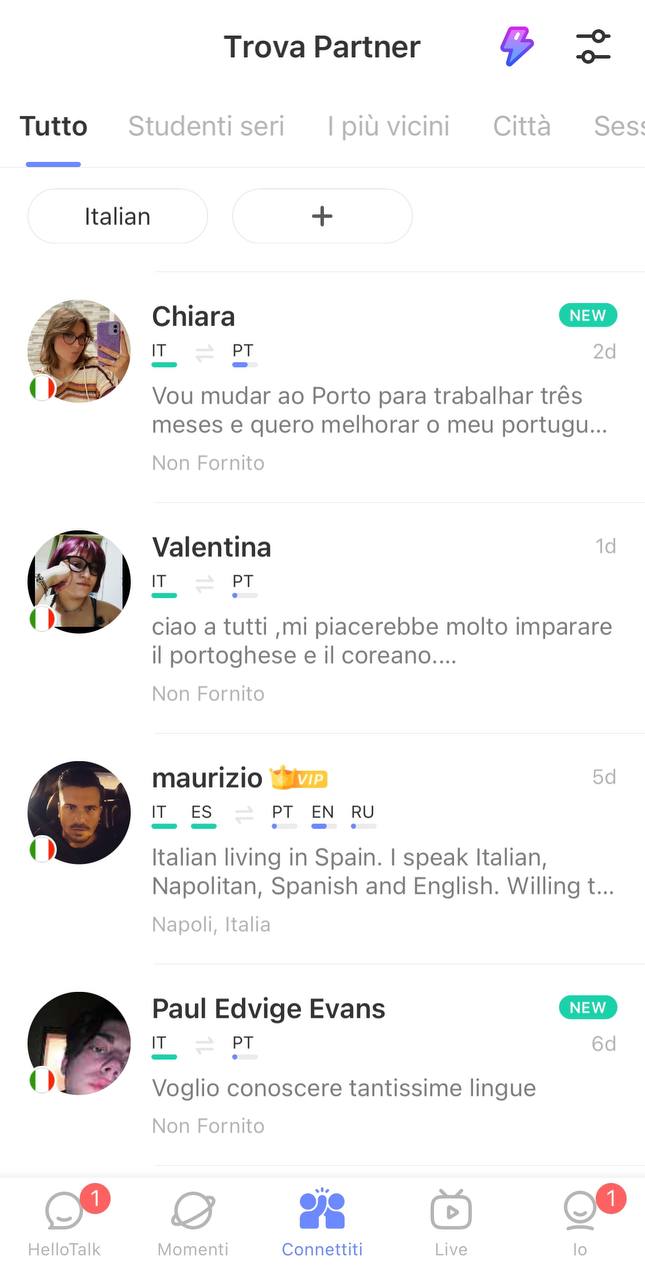
Isn’t it amazing? Just a few clicks and you can find several native Italians who probably love your language to chat with!
The best part is that it’s an app focused on language exchange and healthy friendships without spam or harassment (if it happens, just report it, and the app will block the offender).
6.2 Advantages of HelloTalk App for Those Who Want to Learn Italian on Their Own
The advantages of the app to learn talian on your own are numerous:
- Find native Italians interested in learning your language and passionate about your home country.
- Chat by text and send voice messages to practice pronunciation.
- Correct each other’s messages in case of errors.
- Divide the conversation time between each language.
- Start up to 10 new conversations per day on the free plan.
This app is an excellent way to practice your Italian conversation skills, get feedback from native speakers, and make new friends in the process. It’s a valuable resource for anyone learning Italian on their own.

As features of being able to correct text and send audio freely are very practical for language exchange.
That’s why I suggest you download the app and practice your Italian every day by actively talking to the natives you’ll find on the platform.
It will not only help you practice your written and spoken conversation but also give you the incredible opportunity to make many Italian friends, as happened to me.
I must confess that this app is so powerful that it ended up changing my life forever: it was there that I met Peppe, my Italian boyfriend and life companion since 2017!
Our complete story is for another chapter, but I’ll always be grateful to HelloTalk for allowing us to meet ;D

Me and Peppe in Rome doing what we love the most: exploring every corner of Italy together! From HelloTalk to real life… Who would have thought, right?
7. Consume content from Italian pages on social media
To complete your immersion and increase your exposure to the Italian language, we can’t forget about the place where we spend so much time… social media.
7.1 Best Italian Instagram profiles to follow for learning Italian on your own
I suggest you start by following ALL 15 profiles on the list below and interact whenever you like their content. This way, the algorithm will recommend more and more new Italian content to you.
- 6 Italian IG profiles about travelling: @acchiappamappa , @matterizzi , @travel.mati, @ilsignorfranz , @ireneccloset , @gabdetails , @littletravelsbiglove ;
- 3 Italian IG profiles about news: @ilsole_24ore , @focus_ita , @larepubblica ;
- 3 Italian IG profiles about curiosities: @will_ita, @geopop, @focus_ita ;
- 3 Italian IG profiles that teach Italian: @lets.be.italians , @theitalianlizard, @lucreziaoddone ;
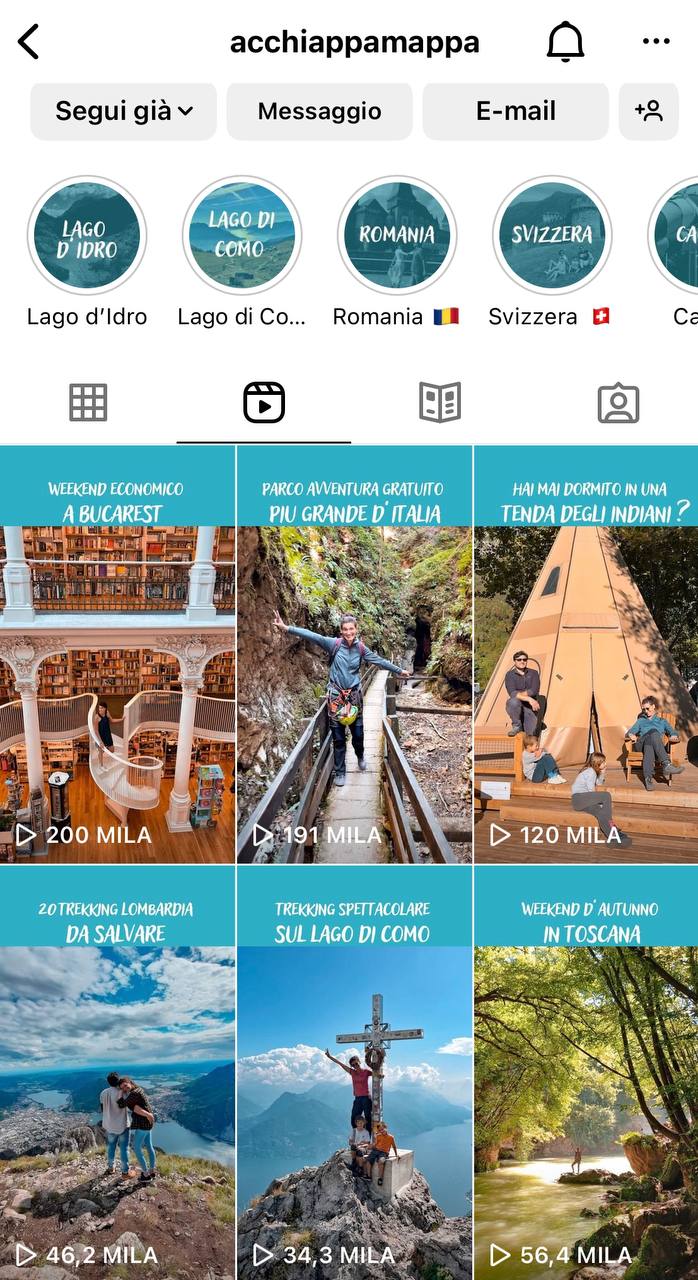
The @acchiappamappa profile talks about family travel in a very light-hearted way, using a lot of stories and reels.
If you don’t really like one of the profiles, you can simply unfollow it, but remember to replace it with another Italian profile so that you always follow at least 15 Italian pages.
This will help maintain a high level of exposure to Italian on social media.
7.2 The top 10 most followed Italians on Instagram in 2022
For the curious ones, I’ve also compiled a list of the top 10 most followed Italians on Instagram in 2022.
I must warn you that these are all profiles of celebrities and VIPs, and not all of them may be considered “constructive” content pages.
Therefore, I recommend that you evaluate what’s worth following based on your own personal taste:
- Top 10 Italians most followed on Instagram: @khaby00 (79,9 M); @chiaraferragni (27,7M); @gianlucavacchi (22,5M); @iammichelemorroneofficial (15,3M); @fedez (14,1M); @valentinorossi (14,1M); @belenrodriguezreal (10,5M); @mb459 (10,5M); @gianluigibuffon (9,9M); @andreapirlo21 (9M);

8. Create a study plan that combines Active Study from the book and Language Exposure
With the book, notebook, and all the techniques in hand, you’re almost ready to take your first steps with Italian.
But before you start studying the book, you need to create a study plan to complete it from start to finish.
Here are 3 tips for building an efficient and achievable study plan to learn Italian on your own from scratch:
8.1 Start by defining the Active Study period (book study)
The biggest reason people give up on studying Italian is starting to study without a plan.
They buy a book, and as soon as it arrives, they try to complete one, two, or even three chapters. But the next day, they already feel tired and do one chapter, then none on the following day, until they eventually give up on the book altogether.
If you want to learn Italian on your own, you need to create a balanced and sustainable study plan, dedicating real Active Study time to complete your book and minimizing the chances of inconsistency leading to quitting.
First, organize your weekly schedule in a spreadsheet or on a piece of paper
On a sheet of paper or an Excel spreadsheet, jot down all your fixed commitments, personal or professional, that repeat throughout a week.

This step is crucial for you to understand how much free time you have to dedicate to studying Italian without disrupting your daily commitments. By organizing a personalized schedule, it will be easier and more enjoyable to follow it from start to finish.
Next, determine the days and times for Active Study and fit them into the weekly schedule you prepared
After defining the schedule for your fixed commitments, you need to establish the times for Active Study in your week (steps 1-3 of the step-by-step guide).
This is the moment when you should sit down at your desk or workspace, open the foundational book, and notebooks to actively engage with studying from the book.

I know it might seem boring, but without a well-defined study time, it’s extremely difficult to learn a language on your own.
For me, it only worked when I started having fixed times to actively study at my desk. It was like having my own language school at home.
Remember that the planning for Active Study in Italian also depends on the book you’ve chosen.
So, when you buy the book and receive it at home, spend the first day examining its structure. How is it divided? Are the chapters long or short?
This information will help you determine the best way to fit the lessons from the book into your week.
For example, if the book is divided into long chapters, you can decide to break it down into two or more days of study. On the other hand, if the book has shorter chapters, you might feel comfortable doing one (or even more) chapters per day.
Suggestion for Frequency and Time Allocated to Active Study
Set a frequency and duration for each active study session, taking into account your personal schedule and the structure of the book you purchased.
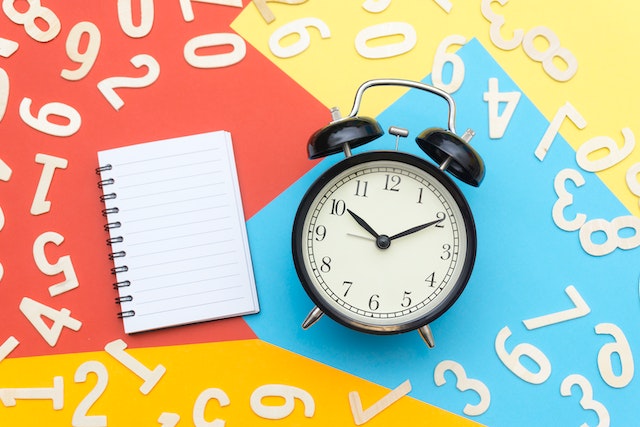
With experience, I’ve learned that there are ideal minimum and maximum limits to optimize the goal of learning Italian on your own:
- Suggested Frequency:
- MIN: 3 times a week, to space out your assimilation and maintain constant contact.
- MAX: 5 times a week, because I believe at least two days off are essential to prevent burnout and quitting. Beyond that, you might start to feel a bit exhausted and inclined to give up.
- Suggested Time:
- MIN: 30 minutes, as it’s the time needed for you to start immersing yourself in the content. If you finish the day’s chapter before that, continue practicing verbs, vocabulary, and exercises until you’ve reached at least half an hour.
- MAX: 1 hour. I recommend respecting the 1-hour limit so you don’t get tired and become less motivated the next day. Of course, if you’re in a good rhythm, you can continue, but don’t overdo it. It’s much better to preserve consistency than to increase study duration.
8.2 Enhance Your Study Plan by Adding Italian Exposure Activities
After setting the active study time, you also need to include time in your study plan for activities that expose you to the language (topics 4-7 of the step-by-step guide).

I recommend:
- Listening to music actively: at least 10 minutes per day (3 songs)
- Watching Italian movies or series: at least once a week
- Conversing with native Italians on the app: at least once every 2 days
- Consuming content from Italian pages on social media: daily
I suggest you first define the day for “Serata Italiana” (Italian night), which is the activity that requires the most time and effort.
You can manage the other activities autonomously, but you need to add them to your study plan in any case to have a reminder and daily motivation to do them and not end up neglecting them.
9. Put Your Plan into Action to Learn Italian on Your Own and Develop Self-Discipline
The most important aspect of this Italian learning journey will be putting your created plan into action and developing self-discipline to allocate time for active study and all the language exposure activities outlined in this guide.
4 Tips for developing self-discipline to study Italian on your own:
- Add the study times from your study plan to your virtual calendar or set an alarm during the week. For example, set an alarm for Monday, Wednesday, and Friday at 9:30 PM for my active study, Thursday at 10:00 PM for the Italian movie, and so on…
- Always do active study while sitting and staying focused. The temptation to study lying down in bed is strong, but for studying with a book and notebook, it’s crucial that you create a dedicated space at a table to read, write, and practice quickly and effectively. Save the couch and bed (so comfortable) for exposure activities like watching movies, consuming content on Instagram, listening to music, and talking to natives.
- Buy a desk calendar, and every day you study Italian, “check off the day.” The feeling of finishing your study session and marking a check on the calendar is simply WONDERFUL. You can use different colors, for example: a green check for active study days, an orange check for exposure with movies, a blue check for exposure with music… The key is to track your consistency!
- Find a friend who also wants to learn Italian by his own. If you have a friend who loves Italy as well, share this post with them, and who knows, maybe they’ll be motivated to start too! That way, you can motivate each other, and both of you can grow together, as you can even practice together.
Recap: the 9 steps to learn Italian on your own
Now you have the roadmap: exactly the same step-by-step process I used to learn Italian on my own.
1. Start by choosing a self-study book as your foundation and follow it from beginning to end.
2. Have 2 notebooks: one large one to follow the book and a smaller one for verbs and vocabulary.
3. Study Italian by always reading aloud, imitating Italian intonation.
4. Learn to actively listen to Italian songs.
5. Watch at least one Italian film per week and gradually increase the difficulty with subtitles.
6. Chat with native Italians using the free language exchange app.
7. Consume content from Italian pages on social media.
8. Create a study plan that combines Active Study from the book and Language Exposure Activities.
9. Put your Solo Italian Learning Plan into action and develop self-discipline.
Don’t postpone it: START TODAY!
GO BACK ABOVE AND CHOOSE YOUR FOUNDATION BOOK.

And remember: regardless of what happens, stay steadfast in your purpose, and never be discouraged if someone tells you that Italian is a “useless” language.
Languages are NOT tools to be judged by their “usefulness.” They are living elements that change over time and also change us!
In my case, learning Italian ended up changing my entire life!
Follow me on Instagram to keep up with my daily life in Italy
Hello, I’m Julia from Querida Itália. I’m a curious carioca, graduated in marketing from Bocconi, and I’ve been living in Italy since 2017.
My goal is to help everyone who is on a journey with Italy, no matter what it may be: traveling, studying, working, or living here!
I share the experiences I’ve accumulated over these years to help people encounter fewer challenges and have more time to be amazed by the wonders of our beloved Italy.
Follow me on Instagram
Read more about


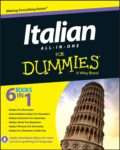
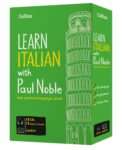
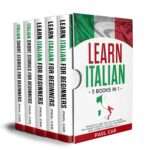
Italian is my fourth language and everything you’ve said is true, desire and then the books, music.
obiragaido. Most important to visit the country when you’re halfway through the language. ancha Grazie.
Ciao, Hudson! 🙂 You’re totally right! It is amazing how our dedication and willing to fully immerse in a language and go beyond grammar (which is also important xD) can truly change the “learning game”.
Great point about visiting the country when we are more confident, indeed it changes everything! I really hope that all Italian students in the world can have the chance to come to Italy, at least once in their learning path.
Un abbraccio e grazie a te!